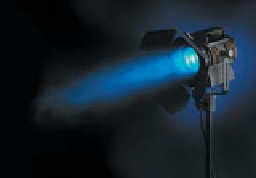Graphics Reference
In-Depth Information
exactly toward the light and 0 for all other directions. A useful constant to remem-
ber is that, for points on the surface of the Earth,
L
0
(in the visible spectrum) due to
the sun is roughly 1.5
m
2
sr. The total power of light in the visible spec-
trum arriving from all points of the sun at a region of the Earth's surface is about
150W
×
10
6
W
/
/
m
2
. Both of these, of course, vary with time of day, season, and latitude.
A spot light models an omni-light shielded by “barn door” flaps or a conical shade.
Theatre lights, flashlights, car headlights, and actual spot lights are examples of
real-world sources for which this model is appropriate (see Figure 14.32). It is
common to choose to model the occluding portion as a perfectly absorptive sphere
with a round iris through which light emerges. It is assumed to be perfectly absorp-
tive so that we can neglect the complex reflections that occur on the silvered reflec-
tor of a headlight and flashlight. The iris is made round because that allows us to
test whether a ray passes through it using a simple threshold of a dot product. A
round iris produces a cone of light.
Let
Φ
be the total power of the omni-light inside the blocker. It is convenient to
specify this rather than the total power actually emitted. Doing so allows a lighting
artist to adjust the spot-light cone independently of the observed brightness of
objects within the cone.
Let 0
be the measure of the angle between the axis and side of
the emitted light cone. Note that
≤ θ ≤ π
θ
=
π
is an iris fully opened so that there is no
Figure 14.32: A theatre light
with square “barn doors”
(left), and a spot light with a
round iris, matching our model.
(Credit: top: Jim Barber/Shut-
terstock, bottom: Matusciac
Alexandru/Shutterstock)
blocker and
=
0 is completely closed. Beware of conventions here. Some APIs
use radians, some use degrees. Also, some specify the full cone angle and some
the half-angle as we have done here.
The measure of the solid angle subtended by a cone with angle measure
θ
0
≤ θ ≤ π
between the axis and side is
2
π
(
1
−
cos
θ
)
.
(14.41)
The fraction of the emitter that is visible through the barn doors is therefore
2
π
(
1
−
cos
θ
)
,
(14.42)
4
π
so the externally observed power
Φ
of an omni-light of power
Φ
occluded by barn
doors is
Φ
=
Φ
2
(
1
−
cos
θ
)
,
(14.43)
which is the
Light::power
value required for implementation in an importance-
sampling renderer.
Spot lights with
4 are used extensively in rendering because they pro-
vide reasonable resolution for a planar projection of light space. That is, by placing
a camera at the light, facing along its axis and with field of view matching the cone
angle, one can render the light's view of the scene with reasonably small distor-
tion at the edges. This technique is used in shadow maps, for example, which are
depth images from the light's perspective, and reflective shadow maps, which are
color images from the light's perspective. Six spot lights, cropped down to square
projections, can cover the six faces of a cube and represent shadowing from an
omni-directional light.
θ ≤ π/





